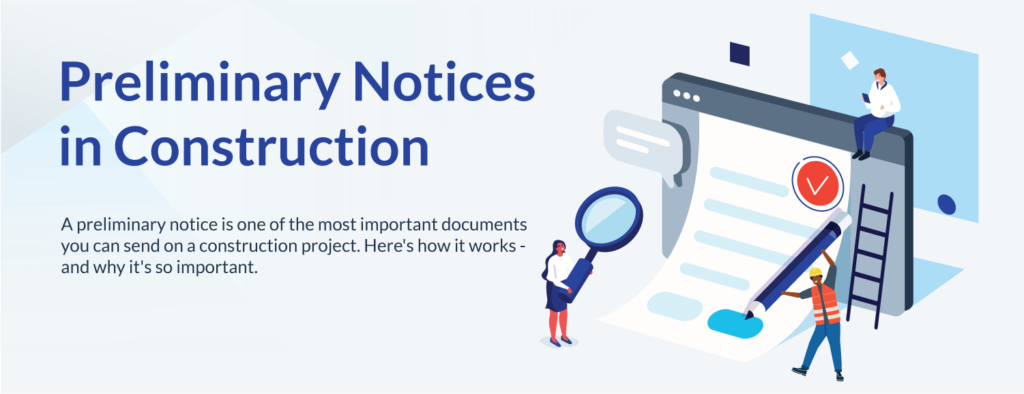
Getting paid on a construction project can be hard work. There are a lot of documents that construction businesses need to exchange in order to receive payment. One of the most underrated documents in construction is the preliminary notice, an informational document sent at the start of a project. It brings enormous benefits to everyone involved in a project, from the property owner down to the smallest equipment supplier. Sending preliminary notice is a critical first step for anyone hired to work on a construction job.
This comprehensive article will explain everything you need to know about preliminary notices, why they’re so important, and best practices for everyone on a construction project.
What is a preliminary notice?
A preliminary notice is a document used on construction projects to provide information to the people in charge (like the property owner and general contractor) about the work being performed. In many states, contractors and suppliers must send preliminary notice to retain the right to file a mechanics lien or make a bond claim if they are unpaid.
Preliminary notices go by a lot of different names:
- Notice to owner (NTO)
- Notice of furnishing
- Prelim
- Pre lien
- And many more…
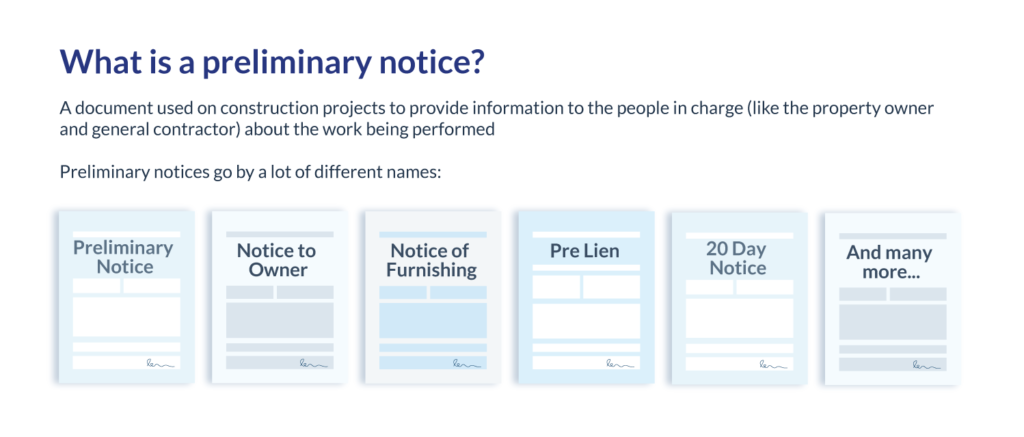
The construction industry uses a variety of notices, but preliminary notices are special – some might even say “magical.” One look at the definition of “preliminary” gives you an idea of how powerful they are:
“denoting an action…done in preparation for something fuller or more important.”
And indeed, preliminary notices are used in preparation for something more important. In fact, it’s the reason why any construction business exists in the first place: Payment.
As you might have guessed, preliminary notice is sent at the beginning of a project, or at least within a few days after work begins.
Why are preliminary notices important?
It all comes back to payments – making them and receiving them. At the end of the day, everyone who works on a construction project wants the same things: to complete the project successfully, and to ensure that everyone gets paid.
It might seem counterintuitive to suggest that property owners want everyone to get paid. You might be thinking, “Wouldn’t the property owner rather not pay anyone?” Of course, everyone financing a construction project wants to minimize their costs. But they also want to avoid legal claims against their property, known as mechanics liens.
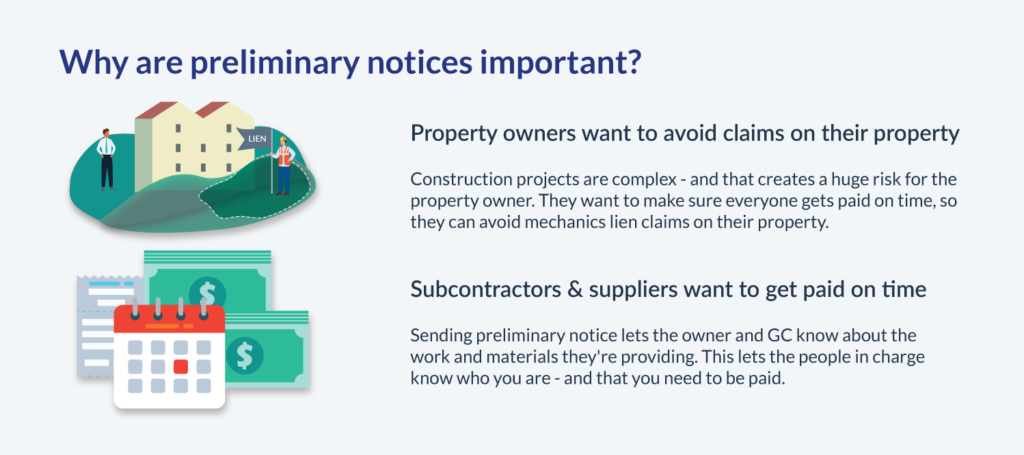
Property owners want to avoid claims on their property
A mechanics lien is a legal document that unpaid construction businesses can use to essentially freeze the property. And the people in charge of a project definitely don’t want that to happen. Unfortunately, the complexity of construction projects can create a huge risk for the owners. If they don’t know who is working on their property, they can’t make sure that everyone gets paid. And if someone doesn’t get paid, they have the right to file a mechanics lien against the property.
In fact, property owners are largely responsible for the existence of construction notices! In the 1960s and 70s, property owners and construction lenders lobbied state governments to help them protect against the problem of “surprise liens.” This lobbying led many states to create laws requiring preliminary notices. The purpose was to give owners and lenders the ability to identify and track the contributors to the job, so that they could pay everyone and proactively avoid lien claims.
Preliminary notices are necessary because a construction project is an expensive, complex, and often risky undertaking. The number of people required to complete a project grows exponentially as the project size increases. For property owners and lenders, these notices help make sure they know everyone who’s working on their project.
Subcontractors & suppliers want to get paid on time
Sub-tier parties, like subcontractors and suppliers, also want to avoid mechanics liens, but for a different reason: They would much rather get paid in full and on time for their work, so they can move on to the next project.
Sending preliminary notices helps sub-tier parties get paid. This is because sending the notice brings their contribution to the attention of the owner, and other people in charge of payments. When the owner knows that a particular company is working on their property, they can take steps to make sure they collect what they’re owed.
Benefits of preliminary notice
Even though they largely help with managing payment on a construction project, preliminary notices bring a number of benefits that reach well beyond a checkbook. They improve communication, send professional signals, help GCs with waiver collection, and can correct an imbalance of power.
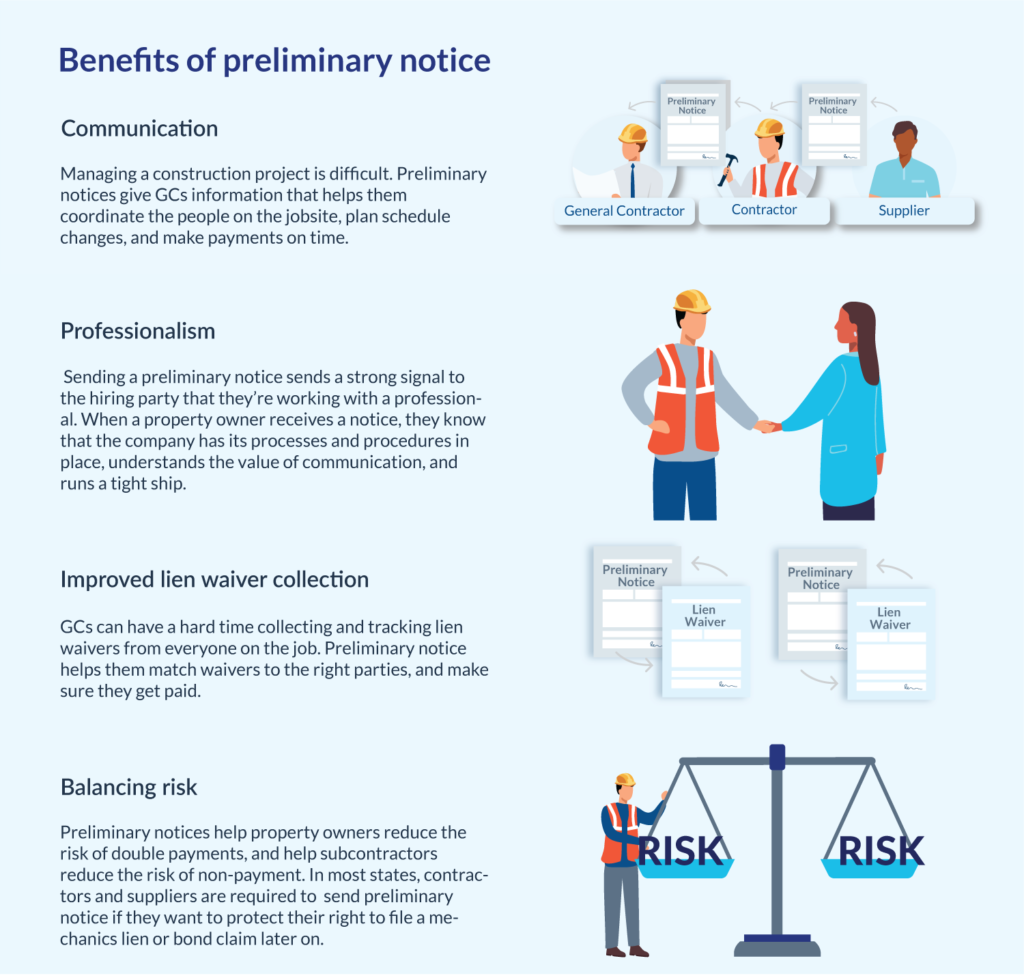
Communication
One of the biggest benefits preliminary notices bring to a construction project is improved communication. General contractors have a difficult job of coordinating everything that happens on a project, from coordinating subcontractors to navigating design changes to ensuring smooth and timely payment. Managing a successful project requires a high level of communication with everyone involved, from the architect down to the sub-subcontractors and material suppliers.
While the GC probably knows how to contact the architect, they might not know how to get in touch with the electrician who was hired by a sub-subcontractor. This is a problem when the architect issues a change order, and the GC has to shift the production schedule around. The electrician needs to know about the schedule change, too. Sending preliminary notice ensures that the GC knows he’s on the job, giving the GC the ability to notify him about important project changes or delays.
Professionalism
In the construction industry, relationships and reputation matter. Everyone wants to hire the most professional outfit to get each part of the job done.
Most property owners and GCs probably have a recurring nightmare that involves a sloppy subcontractor who does shoddy work, doesn’t communicate about what they’re doing, and quits the job as soon as their check clears.
Sending a preliminary notice sends a strong signal to the hiring party that they’re working with a professional. When a property owner receives a notice, they know that the company has its processes and procedures in place, understands the value of communication, and runs a tight ship.
Improved lien waiver collection
General contractors generally need to collect lien waivers from every party on the project in exchange for payment. But identifying everyone who needs to send waivers – and making sure they collect, organize, and track all of the waivers – can be a difficult task. Preliminary notices help avoid headaches when the time arrives for payment. If they collect prelims from every party, they can easily match waivers to them, and make sure that everyone is accounted for.
Balancing risk
A big part of managing a construction project successfully is balancing risk. Preliminary notices help property owners reduce the risk of double payments, and help subcontractors reduce the risk of non-payment. In most states, contractors and suppliers are required to send preliminary notice if they want to protect their right to file a mechanics lien or bond claim later on.
Preliminary notice and the mechanics lien process
A mechanics lien is a powerful tool that contractors and suppliers can use if they don’t receive payment. But it doesn’t just happen automatically. In general, there are 3 required documents that make up the mechanics lien process:
- Preliminary notice
- Notice of intent to lien
- Mechanics lien
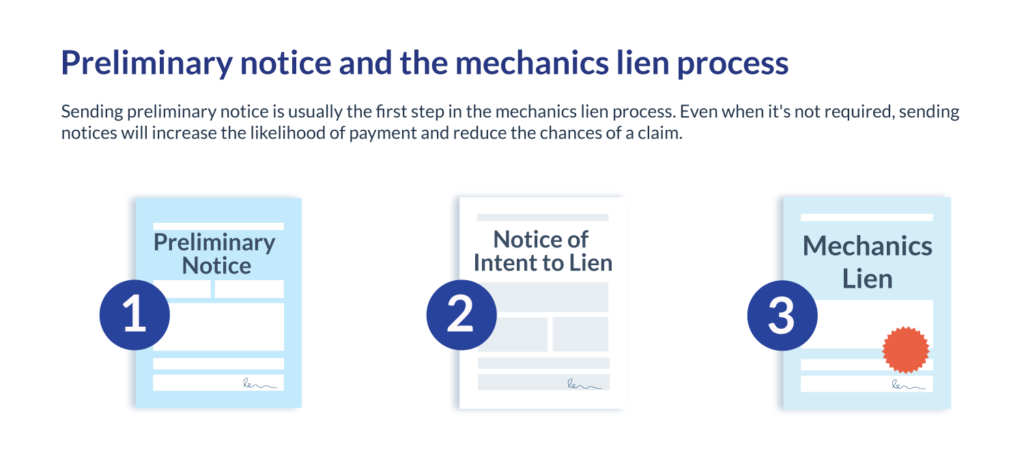
Of course, no one starts a project expecting not to get paid. Too many contractors put themselves in a bad situation because they didn’t think they needed to send preliminary notice – until it was too late.
Unfortunately, that scenario plays out all too often. There are a lot of moving parts that have to line up just right for payments to flow down the chain of contractors and suppliers on a job. Problems occur all the time – but there’s no way to predict when and where they will arise.
That’s why sending a preliminary notice on every single project is simply good business. If it’s not required in your state…send a preliminary notice. When you don’t expect a payment problem…send a preliminary notice. If you’re doing a roofing job on your best friend’s house…send a preliminary notice.
State requirements
In states where preliminary notice is required to protect your lien rights, you’ll need to follow specific requirements. These include sending notice in a specific timeframe, to the right people, by the proper means, and providing complete and accurate information.
However, because of the enormous benefits they provide, it’s a good practice to send prelims even if your state doesn’t require it.

Calculating your deadline
Each state sets their own deadline, and some are stricter about it than others. In California and Arizona, for example, you must send preliminary notice within 20 days of first furnishing labor or materials. But if you miss the deadline, you’re not dead in the water. You can still send one – but the lien protection will be limited to the labor or materials provided 20 days prior to the notice and everything thereafter.
In many other states, the deadline is hard and fast. Failing to send a preliminary notice within the timeframe required means you give up your right to file a mechanics lien entirely. If you don’t get paid, your options to recover payment are much more limited, expensive, and time-consuming.
It’s a good idea to send a prelim as soon as you start any project. This will prevent you from needing to calculate deadlines in different states or on different projects. You can always rest assured that your lien rights are protected.
Information to include on a preliminary notice
While it’s important to check your state’s specific requirements, there is some information that preliminary notices will generally contain:
- Your company’s name & contact information
- Property owner’s name & contact information
- General contractor’s name & contact information
- Lender’s name & contact information (if one exists)
- Bond surety company (if a payment bond exists)
- Property address and/or legal property description
- Description of the work and/or materials you’re providing
- An estimate of the total price
In addition, many states with preliminary notice requirements also require specific notice language on the form that informs the recipient of your right to file a lien if they don’t pay you on time.
Rather than digging into the state statutes and building a preliminary notice document from scratch, simply download a free preliminary notice form created by construction attorneys for free:
Free Preliminary Notice Forms For Construction Projects in All 50 States
Delivering preliminary notice
Most states spell out exactly how preliminary notices can be sent. The best practice is to deliver notice by certified mail with return receipt requested, so that you have a record of the service in case a disagreement arises down the road. States often allow for personal service, i.e. hand delivery, but that can be harder to prove.
Most often, you’ll need to serve notice on the property owner (that’s why quite a few states call it a Notice to Owner). In some cases you’ll need to provide it to the general contractor and, potentially, the lender, depending on the state, project type, and project role.
Regardless of the requirements, it’s a good idea to send notice to all of the parties up the payment chain. You can’t really send preliminary notice to too many people. The more people who know you’re on the job, the more likely you are to receive payment on time.
Project Awareness Letter
A project awareness letter is a type of non-statutory preliminary notice. This means that there aren’t any laws that govern how or when to send it, and it won’t affect your lien rights. It’s a document that gives information to the parties above you about your company. It includes a description of the work that you’re doing, and the contract price you’re working for.
Fundamentally, there’s really no difference between an awareness letter and a prelim. The main difference is that, in preliminary notice states, that information must be delivered in a specific format, by a specific deadline, and in a specific way. In fact, some states require a prelim to contain a statement like “This is an informational notice required by law.”
Construction businesses in states without a statutory preliminary notice may use a project awareness letter instead. While they don’t carry the same legal weight, they include all of the same information. Providing an awareness letter improves communication, provides more transparency, and improves the likelihood of on-time payments in full.
Preliminary notice vs. other construction notices
Construction has a lot of different types of notices that relate to the payment process. Each state has their own names for them. The whole process can feel a lot more complicated than it really is.
It helps to think of a preliminary notice as one that construction businesses send to provide information to the people in charge at the beginning of a construction project. That’s the big difference between this and other types of notices.
Consider the Notice of Intent to Lien (NOI), for example. This is a document that’s sent before a mechanics lien can be filed in some states. It’s only used after a payment has been missed. So it doesn’t make sense to send it at the beginning of a project.
A Notice of Commencement is another type of notice used at the beginning of a construction project. But it’s not used by a contractor or supplier. This document is filed by the property owner (or sometimes the GC) to serve as a public record that a project has started.
In certain cases, states may also require you to actually file a preliminary notice with the county clerk. But that’s not typical.
Video: What to to do after receiving a preliminary notice
Best Practices For Preliminary Notices
Below are some best practices for property owners, general contractors, and sub-tier construction parties to use preliminary notices to their respective advantage. If you want to dig deeper, try this free download: The Guide to Best Practices for Preliminary Notices.
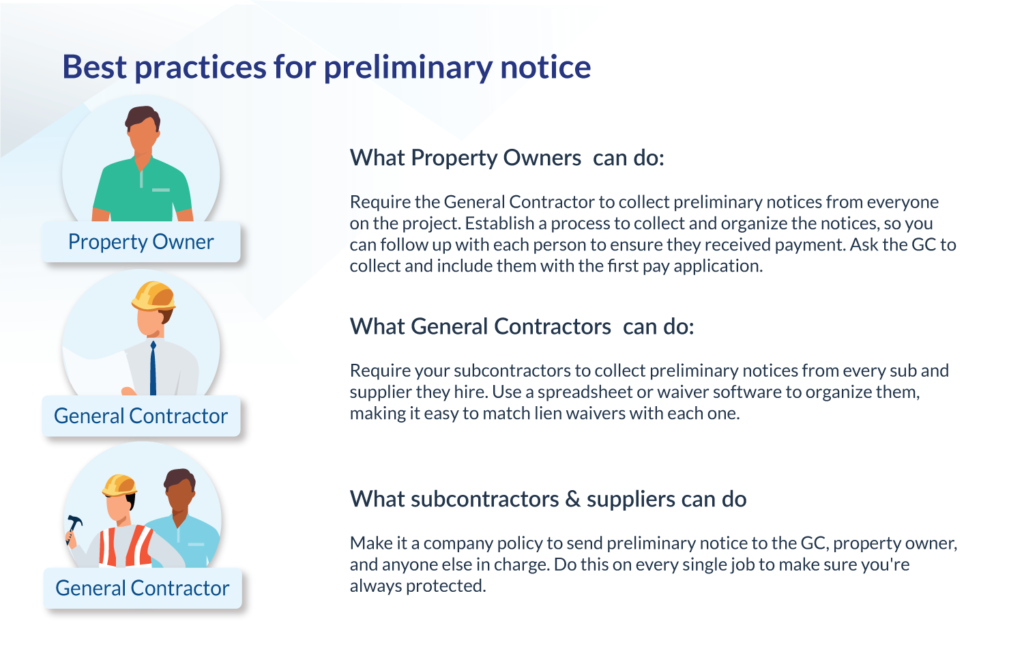
What Property Owners Can Do
It can be difficult for property owners to identify everyone on their project and make sure they’re paid. And that difficulty can lead to missed payments…which can lead to mechanics lien claims. So preliminary notices can actually be incredibly helpful. Owners and GCs should love receiving preliminary notices!
Because of this, it’s a good idea to put a preliminary notice requirement in your contract with the general contractor. Make collecting notices a concrete, requisite part of the process. This process is a critical part of avoiding lien or bond claims.
If you’re a property owner, the main thing to do when you receive a preliminary notice from a contractor or supplier is to keep a record of it. Establish a process to collect and organize all of the preliminary notices you receive. Or ask the GC to establish this process, and present it to you with the pay applications. (Even better if you both have a process, so you can compare your records as an added level of protection.)
When it comes time to submit payments, you can use these records to double-check pay applications and track that payments are going to the right people.
What General Contractors can do
General contractors have a more complicated relationship with preliminary notices. While they receive them from sub-tier parties, GCs must often send prelims in order to protect their own lien rights as well.
When it comes to managing a project, general contractors and property owners often have the same interests: Finishing the project on time and avoiding lien claims from sub-tier parties. They also have the same problem: It’s hard to see everyone who’s working on a project, much less collect prelims from all of them. Worrying about mechanics lien claims keeps a lot of GCs and property owners up at night.
So wouldn’t it be better to ask subs and suppliers not to send preliminary notice, so they don’t have lien rights in the first place? That’s the solution that some GCs come up with, but it’s a really bad one.
First of all, a GC can’t legally prevent someone from sending a notice. Sure, you can use your leverage to bully them into submission – but you’ll quickly find that subcontractors (and property owners) don’t want to work with you.
And second, this ignores the actual benefits that preliminary notices provide (see above). A much better solution is to require prelims from every single party on the project. Put it in your subcontracts – that the subcontractor must get all of their subs and suppliers to send preliminary notices, too.
The more visibility you have into who is working on your project and the work they’re doing, the better you will be at ensuring payment to all of them. This protects you (and the property owner) against non-payment claims.
Collect & track notices effectively
On most projects, the task of actually collecting and tracking preliminary notices from every sub, sub-sub, and supplier will fall to the GC. The best way to manage this process is to use a system to track which parties on a project have provided a preliminary notice, and when those parties sent the notice.
Whether this process involves a waiver tracking spreadsheet you manage in-house or a software platform that does the tracking automatically is up to you. But if you just receive preliminary notices without giving any thought to connecting them to the party that sent them, you can lose the benefits that they bring.
What subcontractors & suppliers can do
Believe it or not, you have the same goals as the property owner and GC, too: You want to avoid a mechanics lien or bond claim. You’d much rather get paid fairly for your work so you can invest that money in other projects.
Sending preliminary notice is a really important step to achieving this goal. Construction companies that send a prelim are more likely to get paid in full and on time – without ever having to file a claim for non-payment.

Discover how sending notices helped a restoration company shorten their payment cycle to 17 days.
As soon as you sign a contract, you should put the steps in motion to send your preliminary notice. Identify the information you need to complete the notice, and send a request to the GC and/or property owner to make sure you have everything you need. This information will be useful for other documents as the project progresses, so it’s a good idea to keep it in one place, like a project information sheet.
The main takeaway for sub-tier parties is this: Send preliminary notice on every single project. Don’t waste time trying to figure out the risks of non-payment on each project, so that you only send notice on “problem jobs.” You might get the calculation right, but you won’t get it right every time.
Just establish a policy of sending a prelim every single time, as soon as your work on the project begins. This will protect your lien rights when you need them, but in the majority of cases it will ensure you get paid what you’ve earned; on time and in full. After all, isn’t that the goal?


